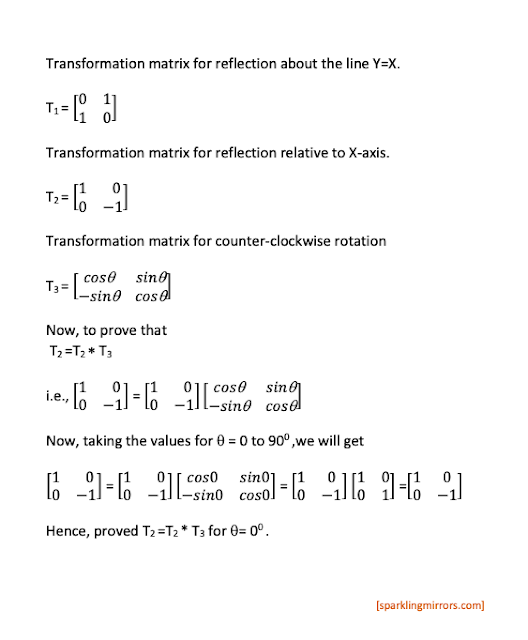Vector in R space.
Tuple = A tuple is a finite ordered list of elements sequence of n-elements where n is a non-negative integer.
Note: O-tuple = Empty space
Eg. (0,0,0,0...........)
A particular n tuple in Rn
U = ( a1,a2,a3,..................an ) is called a point or vector.
[ where, (a1,a2,a3,.............an) is called Scalar & U is called Vector.]
[ where, (a1,a2,a3,.............an) is called Scalar & U is called Vector.]
or,
U = [a¡] ,where i is called as components/entries/co-ordinates/elements.
Note: Elements of R = Scalar .
1.) Two vectors U & V are equal i.e U=V if they have same number of components and the corresponding components are equal.
e.g.
U =[a1,a2,a3]
V =[b1,b2,b3]
If U =V then
a1=b1 , a2=b2 , a3=b3
2.) U=[0,0,0..........0]
This is Zero vector and is denoted as Bold 0 (𝐨).
Example :
Q) Identify the space :
a) (2,-5) -> R2
b) (3,4,5) -> R^3
Q) Find x,y,z such that (x-y , x+y , Z-1)=(4,2,3).
x+y=2 (ii)
z-1=3 (iii)
From equation (iii) we will get, Z=4
Solving equation (i) & (ii),we will get,
2x=6 => x=3
putting value of x=3 in equation (i),we will get
y=-1
So, X=3,y=-1,Z=4
In vector form (3,-1,4).
COLUMN VECTORS :
Vector is n-space Rn is written horizontally as well as vertically.
eg.

This is R^4. (Vector in 4 space )
Note: Operation defined for row vectors is analogous for column vector.
eg.
1.) U=[1,2] , V=[3,4]
U+V=[4,6]
2.)

Row and Column matrix addition is not possible.
VECTOR ADDITION:
Suppose two vector U = (a1,a2,a3............an) & V = (b1,b2,b3............bn) U & V are in same Rn .
So,U+V=( a1+b1,a2+b2,a3+b3...................an+bn)
SCALAR MULTIPLICATION:
Let k be any Real number.
U=(a1,a2,a3,..............an) in Rn .
kU=(ka1,ka2,ka3.............kan)
Note: Negatives & Subtraction are defined in Rn as follows :
-U =(-1)U. => Negatives of U.
U-V=U+(-V) => Difference of U & V.
LINEAR COMBINATION OF VECTORS:
Let U1,U2,U3...............Un are vectors in Rn & V1,V2,V3.........Vn are vectors in Rn .
M=U1V1 + U2V2 + U3V3 +..............+UnVn.
(Where M is Linear Combination of vectors.)
Note: Zero vector 0 =(0,0,0..............0) in R is similar to scalar 0 in R.
Example :
Q) Take U=(2,-3,6) ,V=(9,2,-8) Find :
(i) U+V (ii) 7U (iii) -V (iv) 5U-3V
Soln:
(i) U+V = (2+9,(-3)+2,6+(-8)) => (11,-1,-2)
(ii) 7U = 7*(2,-3,6) => (14,-21,42)
(iii)-V = -1*(9,2,-8) => (-9,-2,8)
(iv)5U-3V = 5*(2,-3,6) - 3*(9,2,-8)
= (10,-15,30) - (27,6,-24)
=((10-27),(-15-6),(3-(-24)))
=(-17,-9,27) Ans...
soln:
x-y=4 (i)x+y=2 (ii)
z-1=3 (iii)
From equation (iii) we will get, Z=4
Solving equation (i) & (ii),we will get,
2x=6 => x=3
putting value of x=3 in equation (i),we will get
y=-1
So, X=3,y=-1,Z=4
In vector form (3,-1,4).
COLUMN VECTORS :
Vector is n-space Rn is written horizontally as well as vertically.
eg.

This is R^4. (Vector in 4 space )
Note: Operation defined for row vectors is analogous for column vector.
eg.
1.) U=[1,2] , V=[3,4]
U+V=[4,6]
2.)

Row and Column matrix addition is not possible.
VECTOR ADDITION:
Suppose two vector U = (a1,a2,a3............an) & V = (b1,b2,b3............bn) U & V are in same Rn .
So,U+V=( a1+b1,a2+b2,a3+b3...................an+bn)
SCALAR MULTIPLICATION:
Let k be any Real number.
U=(a1,a2,a3,..............an) in Rn .
kU=(ka1,ka2,ka3.............kan)
Note: Negatives & Subtraction are defined in Rn as follows :
-U =(-1)U. => Negatives of U.
U-V=U+(-V) => Difference of U & V.
LINEAR COMBINATION OF VECTORS:
Let U1,U2,U3...............Un are vectors in Rn & V1,V2,V3.........Vn are vectors in Rn .
M=U1V1 + U2V2 + U3V3 +..............+UnVn.
(Where M is Linear Combination of vectors.)
Note: Zero vector 0 =(0,0,0..............0) in R is similar to scalar 0 in R.
Example :
Q) Take U=(2,-3,6) ,V=(9,2,-8) Find :
(i) U+V (ii) 7U (iii) -V (iv) 5U-3V
Soln:
(i) U+V = (2+9,(-3)+2,6+(-8)) => (11,-1,-2)
(ii) 7U = 7*(2,-3,6) => (14,-21,42)
(iii)-V = -1*(9,2,-8) => (-9,-2,8)
(iv)5U-3V = 5*(2,-3,6) - 3*(9,2,-8)
= (10,-15,30) - (27,6,-24)
=((10-27),(-15-6),(3-(-24)))
=(-17,-9,27) Ans...





Comments